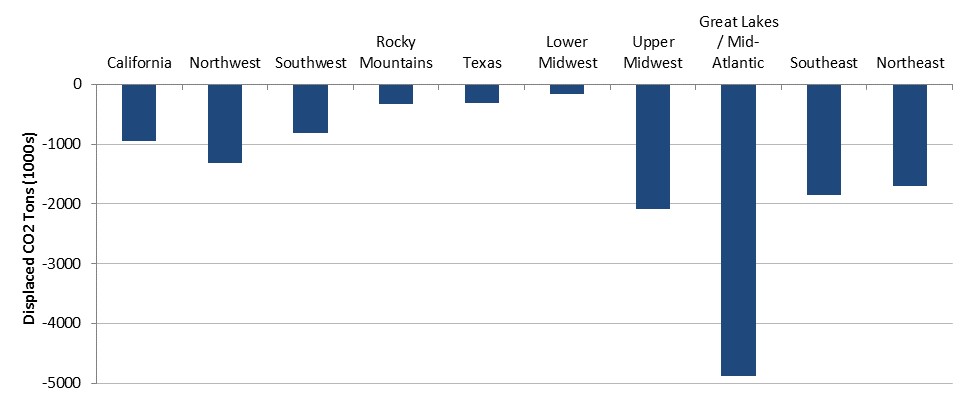Clean Energy Resources Most Effective in Reducing Emissions in Coal-Heavy Regions
One of the key benefits associated with energy efficiency and renewable energy programs (clean energy) is that they reduce consumption of fossil fuel resources, and in doing so reduce fossil fuel-related carbon dioxide (CO2) emissions. A report released by Synapse today provides evidence that clean energy resources have indeed displaced emissions—at a rate of up to 0.80 metric tons of CO2 per megawatt-hour, depending on the region and the type of alternative resource deployed—and are projected to continue to do so in the future.
The report, Air Emissions Displacement by Energy Efficiency and Renewable Energy: A Survey of Data, Methods, and Results, presents a comprehensive review of analyses at the utility, regional, and national level that (directly or indirectly) estimate displaced emissions rates. Synapse also modeled the impact that energy efficiency and renewable energy have on fossil fuel consumption by grid-connected electric generators using EPA’s AVERT.
The degree to which clean energy resources reduce emissions is dependent on a number of factors, including the type and amount of traditional resources displaced. “The larger the proportion of higher carbon-emitting resources in a region’s existing generation capacity mix, the larger role energy efficiency and renewable energy can play in displacing CO2 emissions,” according to the report. This is evident in the range of displaced emissions rates reported by regional transmission organizations (RTOs), the entities responsible for dispatching electricity over large areas of the country. The Synapse report compares the findings from four RTOs that report emissions displacement rates—or marginal fuel data that imply displacement rates—ranging from 0.30 to 0.80 metric tons per megawatt-hour over the past year.
Synapse’s own independent modeling confirms both the pronounced effect that clean resources can have on reducing emissions and the significance of the region’s existing capacity mix. Synapse modeled two case studies with AVERT, a tool that uses historical generation and emissions data reported to the EPA by U.S. power plants to estimate the hourly emissions and generation benefits of clean energy policies and programs. The case studies explore (1) the potential for energy efficiency and renewable energy programs to displace emissions in 10 U.S. regions and (2) actual displaced emissions from new energy efficiency in 2012. In both case studies, clean energy programs have a greater effect in regions that have a higher percentage of coal-fired capacity. Of course, the level of aggressiveness of a region’s clean energy programs also has a substantial impact on the emissions displacement rate.
Figure 1. CO2 emissions displaced by incremental energy efficiency programs in the U.S., 2012

In addition to analyzing the regional impact, the Synapse report reviews national- and utility-level data to infer displaced emissions rates at lower and higher resolutions. To learn what Synapse found by reviewing the U.S. Energy Information Administration’s Annual Energy Outlook and IRP studies from three large utilities—and to dive deeper into the regional data—read the full report.